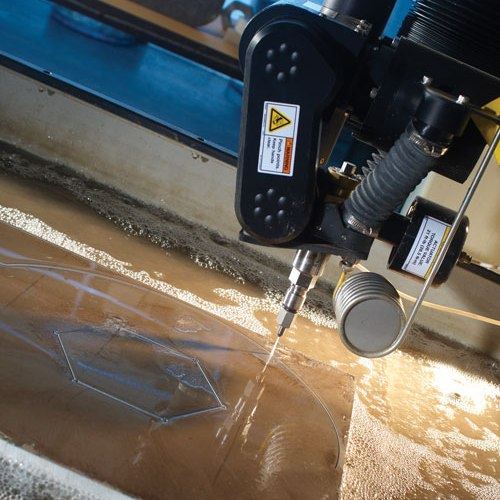In abrasive waterjet machining, does higher pump pressure translate to faster cutting? Waterjet machine tool maker Omax says that beyond a certain point, the answer is no.
The company, which is based in Kent, Washington, recently ran tests comparing waterjet cutting using a pump delivering 60,000 psi against a pump delivering pressure nearly 50 percent greater. Motor power was equivalent, with 50-hp and 100-hp motors used at each pressure level. The test cuts were run in 1-inch and 2-inch-thick aluminum, as well as in 2-inch-thick steel. In all of these cases, says Omax, the lower-pressure machine cut faster. (Click on the table at right to enlarge.)
Dr. John Olsen is vice president of operations with Omax. He says the reason increased pressure doesn’t necessarily assist cutting has to do with abrasive flow. Power is proportional to flow times pressure, he notes. As a result, “for a given electrical input power, any increase in pressure must be matched by a decrease in volume flow rate. This means that a higher-pressure pump must use a nozzle with a smaller orifice.” Thus, the 50-hp pump that would use a 0.014-inch nozzle orifice at 60,000 psi is constrained to a 0.010-inch orifice at 90,000 psi, he says.
In waterjet applications in soft materials where the water alone does the cutting, a smaller-diameter jet stream might be more effective. But in abrasive waterjet applications, it’s the abrasive doing the cutting rather than the water. The water’s role is to accelerate the abrasive particles. A smaller-diameter stream “actually carries less momentum for entraining and accelerating abrasive particles than a lower pressure jet of the same horsepower,” Dr. Olsen says.
Efficiency might be the better indicator of cutting performance. That is, how well motor power is converted into power at the nozzle. A direct-drive pump delivering 60,000 psi features lower efficiency losses than pumps designed to achieve higher pressure, Dr. Olsen says. This means less of the power of the motor is wasted as heat. He says a 50-hp direct-drive pump can deliver about 45 hp to the nozzle. Higher-pressure pumps potentially impose greater power losses than this. They also impose costs related to the added strain of the higher pressure on the machine’s valves, tubes and fittings. Because of all of these costs, he argues that there is significant value in discovering just how much cutting performance a 60,000-psi waterjet machine can deliver.
Related Content
-
Lathes represent some of the oldest machining technology, but it’s still helpful to remember the basics when considering the purchase of a new turning machine.
-
By employing advanced high efficiency milling techniques for the entire machining routine, SolidCAM’s iMachining technology can drastically reduce cycle times while vastly improving tool life compared to traditional milling.
-
Because of the high material removal rate creep-feed grinding can deliver in challenging materials, grinding might not be just the last step in the process—it might be the process.
.jpg;maxWidth=970;quality=90)
.jpg;width=70;height=70;mode=crop)





.jpg;maxWidth=300;quality=90)






.png;maxWidth=300;quality=90)
